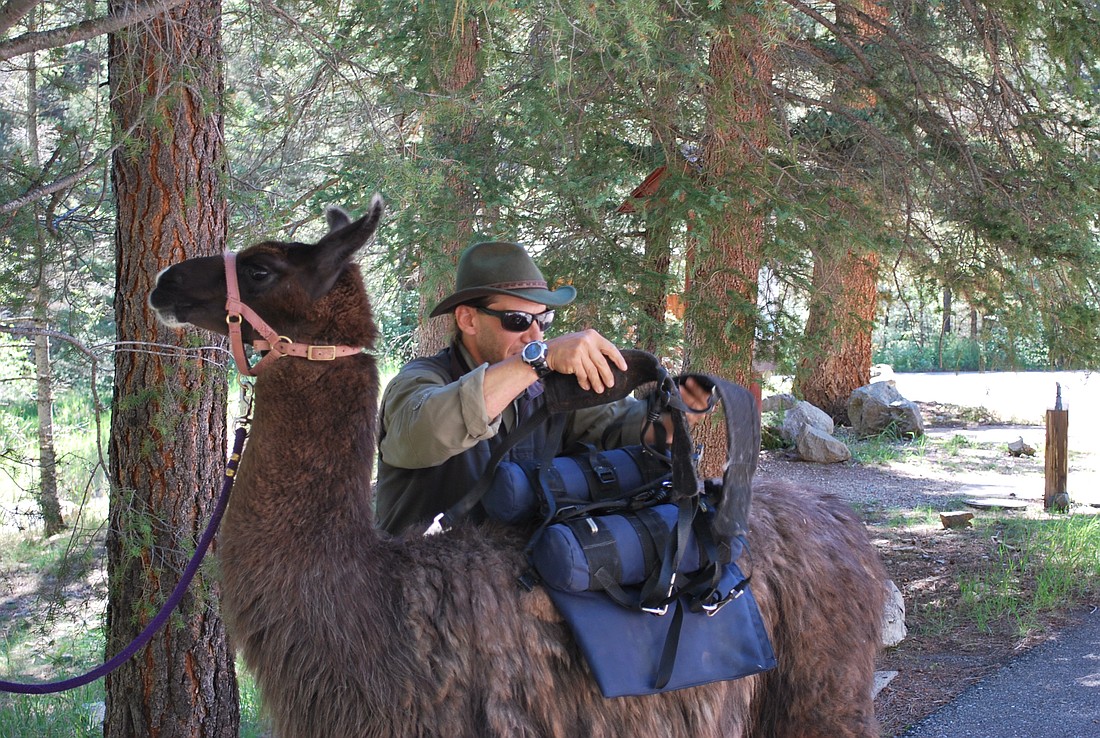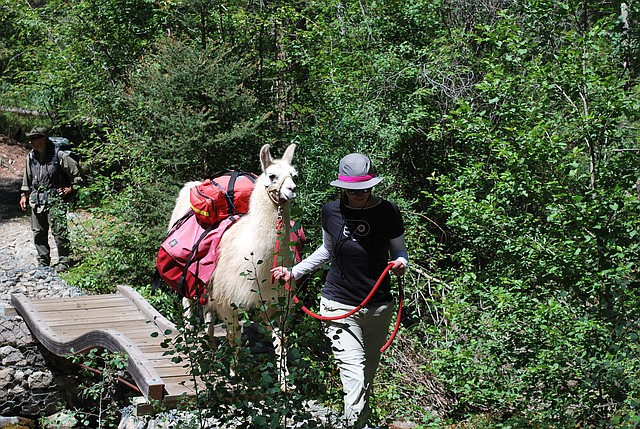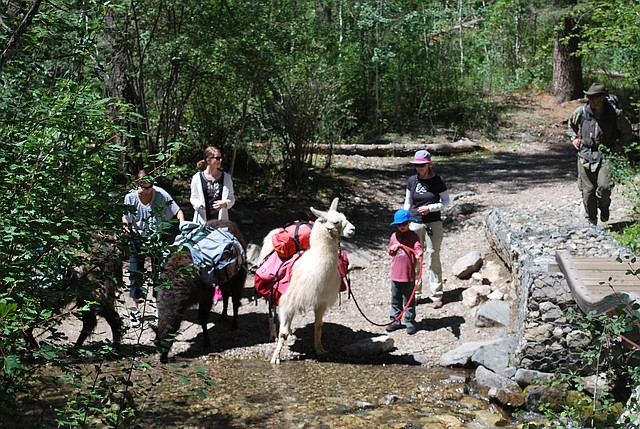'Silent brothers' make ideal hiking companions
July 28, 2014 at 6:00 a.m.
Among those I have taken to lunch over the years, I can now add a llama to my list. My dining companion, K-2, was one of six llamas that accompanied our small group on a recent day trek with Wild Earth Llama Adventures in Northern New Mexico. A handsome blonde and statuesque creature with plenty of personality, K-2 was ever-alert and curious as we hiked the trails in the Columbine Hondo Wilderness Area of the Sangre de Cristo Mountains.
I led my trusted wooly friend through the dense woods, over bridges and into the gentle creeks within this picturesque and unspoiled wilderness. With his leather padded, two-toed feet and natural agility, he walked with a self-possessed air, exuding confidence as he navigated the terrain without faltering, while carrying a load of gear. “Llamas are the perfect low-impact, high altitude pack animal,” says Stuart Wilde, owner and head wilderness guide of Wild Earth Llama Adventures. ‘They are sure-footed because they have the perfect ‘mountain moccasins’ - like mountain goats - and they have little impact on fragile wilderness trails. They exemplify the ‘leave no trace’ ethic we practice and teach out here.”
Wilde, who started leading wilderness trips in this area 22 years ago, notes that llamas make great hiking companions, adding, “The word ‘llama’ in Spanish is pronounced ‘yama’ and means ‘silent brother.’ Who else would carry your stuff for miles without saying a word?” He explains that llamas are very intelligent and gentle creatures and adds that like humans, they are equally excited about being out and about in the mountains. They walk at a comfortable pace for hikers at all levels and their keen sense of smell, hearing and sight will often spot a distant herd of deer or elk. They are also extremely lovable animals and bond with people well.”
Wilde continues to explain that the llama is a member of the camel family and is one of the oldest domesticated animals with a history of helping people carry their wares for thousands of years. Those that are well-trained will eagerly follow adults and kids alike, which enables outfitters to facilitate wilderness experiences with a wide range of individuals.
Wilde currently has nearly forty llamas at his ranch that he has rescued from unwanted, neglected and often abandoned situations. He receives calls and emails on a regular basis from people and municipalities throughout the Southwest asking him to pick up the creatures and give them a new home. He says, “Many folks get these animals as an exotic pet or breeding investment and sadly, the novelty wears off in a few years or the llama market didn’t meet their expectations. Most of the llamas are already adults by the time we get the call and they have usually never been haltered, handled or groomed. Often they are feral and the majority is just plain scared.”
Wilde’s aim is not to breed or sell the llamas, but simply to provide them with a good home where they can live out the rest of their lives. He adds, “We actually stopped needing more llamas for our trekking operation when we reached sixteen. We do this out of our love for the animals and as a way to give back to them for what they have given our family and to the thousands of people who have trekked with us.”
On my adventure, there were eight of us, including two children, plus Wilde, along with the llamas – all males or “machos.” K-2 was joined by his buddies Picchu, Rio, Raja, Diego and Zephyr. As we hiked, Wilde kept us entertained and educated with information about the environment. He pointed out the native flora and fauna, as well as a number of edible and medicinal plants, while providing some details about the natural and regional history of the area. The pace was relaxed and non-competitive and the emphasis was on simply enjoying the backcountry.
Lunch was in a lush meadow on the bank of the Columbine Creek, where we tethered the llamas so they could munch to their hearts’ content on the grass and nearby bushes. Meanwhile, we humans watched in amazement as Wilde unloaded a foldout table, stadium style seats, coolers and an assortment of supplies from the packs on the llamas. He proceeded to assemble a tasty, gourmet lunch with all the trimmings, which we heartily devoured. Perhaps my wooly companions would disagree, but I felt that our sumptuous spread far outranked their “green” buffet.
Afterwards, we headed back down the trail with K-2 and I assuming the lead. It quickly became very obvious that my hiking pal was eager to get home. He inched increasingly closer to me and soon I could smell his alfalfa-scented breath on my neck. As I picked up my pace to get a bit more distance between us, he followed suit, practically stepping on my heels in the process and almost breaking out into a trot. We made quite an amusing spectacle and just as I was ready to call, “uncle!” Wilde stepped in and facilitated a llama swap for the remainder of the journey. My new companion, Rio, proved to be less interested in reaching the trailhead and more keen on eating whatever and whenever he could along the way.
“These guys are total goofballs,” comments Wilde. “They are very playful and can be real characters, which is why they’re so much fun!” He adds, “I love being around them and I get great satisfaction from seeing people interact with them for the first time.” For Wilde, being a wilderness guide has both professional and personal rewards. He takes pleasure in giving people the opportunity to reconnect with the natural world and do things they might not otherwise get to do, while being able to spend most of his days in the wilderness doing what he enjoys most. “You can’t get a better than this for an office!” he says.
Wilde has taken thousands of people from around the world on llama treks. Many come for a day hike the first time and then return for a multi-day experience the following year. He adds, “My hope is that leading unique and memorable wilderness experiences will help to foster a greater sense of stewardship and promote conservation of our public wild lands.”
If you go: Wild Earth Llama Adventures offers single-day escapes and multi-day wilderness adventures in the Sangre de Cristo Mountains and Rio Grande Gorge near Taos and Santa Fe, NM. Small group and custom-designed private tours are available. For more information: www.llamaadventrues.com or 800-758-5262. To complete your experience, spend the night in Taos before and/or after your trek at the fabled Historic Taos Inn (www.historictaosinn.com) and make sure to have dinner at the legendary and award-winning Doc Martin’s Restaurant on site. It’s a happening spot with live music in the lounge, killer margaritas and inventive Southwestern cuisine.
Deborah Stone is a travel and lifestyle writer, who explores the globe in search of unique destinations and experiences to share with her readers. She’s an avid adventurer who welcomes new opportunities to increase awareness and enthusiasm for travel and cross-cultural connections. Her stories appear in a number of publications as well as on various travel websites. Additionally, she can be frequently be heard dishing travel with the hosts of the NPR-affiliated and AARP produced talk radio show, “2 Boomer Babes.” Deborah is a longtime Seattle area resident, who currently resides in Santa Fe, New Mexico.







